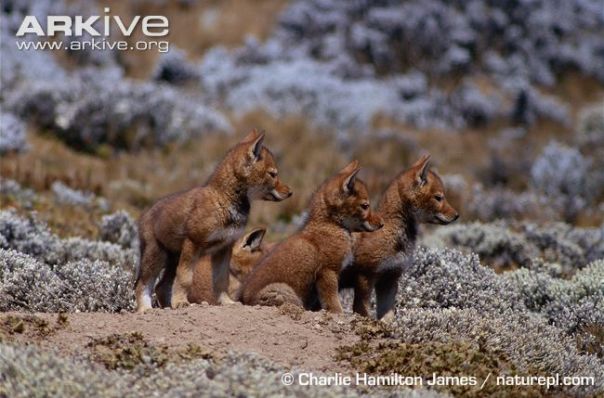- Name: Ethiopian wolf
- Latin: Canis simensis
- Classification: Mammal
- Origin: Ethiopia, Africa
- Lifespan: 8-10 years
- AKA: Red fox, red jackal, simien fox
Taxonomy
Kingdom: Animalia (Animals)
Phylum: Chordata (Vertebrates)
Class: Mammalia (Mammals)
Order: Carnivora (Carnivores)
Family: Canidae (Dogs)
Genus: Canis (Wolves, Dogs and Jackals)
Species: Canis Simensis (Ethiopian Wolf)
Apperance
Length: Average of 3.3ft
Weight: 24-42lbs
The Ethiopian wolf is very fox-like in appearance with its long legs and muzzle more pointed that its European cousins. It has a reddish coat with white underside and a black tip to its tail. The colour of its fur often gets darker with age.
Relatives
- Grey wolf (Canis lupus) -LEAST CONCERN-
- Red wolf (Canis rufus) -CRITICALLY ENDANGERED-
- Maned wolf (Chrysocyon brachyurus) -NEAR THREATENED-
- Himalayan wolf (Canis himalayaensis) -CRTICALLY ENDANGERED-
Habitat & Distribution
Packs of Ethiopian wolves tend to live in isolated pockets of alpine grassland and Heathland where there are plenty of rodents to feast on. They live at high altitudes of 3,000 meters above ground level in Ethiopia, Africa.
The rainfall at these high altitudes varies between 1-2m/year and have one pronounced dry seasons from December to February/March.

Diet
Ethiopian wolves are carnivores and their diet mainly consists of the rodents that are abundant in their homes. They will hunt and eat hares, giant mole rats and common grass rats. They have also been known to feed on eggs, goslings and young ungulates and will occasionally scavenge on carcasses.
They have strong social bonds but spend most of their day hunting alone. They hunt by sneaking up of their prey silently and pouncing when close enough.
Behaviour
Ethiopian wolves form strong social bonds with others in their pack but spend the majority of each day hunting individually for rodents. They are territorial candids that form territorial packs. The packs contain roughly 12 adults with a skewed mating ratio with several males for each female.
They congregate for social greetings and border patrols at dawn, noon and evenings and rest together at night. They use scent to mark their territories via urine posts, scratching and faeces. Vocalizations are also common in advertising and maintaining territories.
Aggressive interactions with neighbouring packs are common. These are always highly vocal and always end with the smaller pack fleeing from the larger.
Reproduction
Mating between Ethiopian wolves occurs between August and November. This includes a short courtship which involves the male accompanying the female wherever she goes. Females are receptive to all males including those outside the pack. Up to 70% of matings involve male from outside the pack.
The females give birth once a year between October and December. The pups are born with their eyes close, no teeth and a dark coat, the latter of which becomes lighter once they leave the den. This occurs about 3 weeks after birth. The pups are kept in a den dug by the female and are regularly shifted between dens to ensure their safety.
It is the responsibility of all members of the pack to help guard the den, chase away potential predators and bring hunted food to the pups. Subordinate females may assist the dominant female in suckling her pups. At least half of the extra nursing females show signs of pregnancy and may have lost or deserted their own offspring before joining the dominant females den.

Adaptations
- The Ethiopian wolf has a narrow, pointed muzzle, ideal for fitting into rat holes to catch their prey.
- The Ethiopian wolf has small, widely spaced teeth which helps it to hold on to small, wriggling animals.
- The Ethiopian wolf tends to hunt alone which matches the habits of its prey. A large pack is not required for taking down rodents and the wolf does not have to share his kill with others.
- The dark orange colouring of the Ethiopian wolf’s fur provides excellent camouflage for it, meaning it can sneak up on its prey undetected.
Threats
Ethiopian wolves are one of the most endangered species of canine with their worldwide population being less that 500 separated into only seven isolated populations. They live in packs in altitudes as high as 10,500 feet.
Their threats include destruction of habitat by human populations to make way for farmland, roads and areas for livestock grazing. This loss of habitat forces them closer to humans, which is the cause of another of their threats. Ethiopian wolves can catch disease from domestic dogs, such as rabies and sometimes canine distemper.
Another big killer of these wolves is the hunting and poisoning of them by human farmers. It is widely believed that they hunt and eat the farmer’s livestock. However, this belief is in fact false. Ethiopian wolves feed primarily on rodents, and hunt solitary. A singly wolf would not be able to take down an animal such as a cow or even a pig on its own.
Conservation
IUCN Status: Endangered
There is a huge organisation designed solely to protect the Ethiopian wolf called the Ethiopian Wolf Conservation Programme (EWCP). It was founded in 1995 by Dr. Claudio Sillero. The strategies designed for the conservation of this wolf also protects the fragile afroalpine ecosystem of Ethiopia, Africa.
The EWCP protected the Ethiopian wolf by monitoring their numbers and where they live. It also vaccinates domestic dogs to reduce the spread of disease, provides a comprehensive education programme for local school children and employs local residents which raises the standards of living of the people of Ethiopia and in turn raises motivation to protect the wolf.
Fun Facts
Male: Brute
Female: Bitch
Young: Pup
Group: Pack
-Is an animal of many names including Abyssinian Fox, Red Fox, Red Jackal, Simien Fox and Simien Jackal.
-They are more closely related to wolves and coyotes than to the foxes they so closely resemble.
-They live in packs which involve about 3-13 individuals.
-One of the most endangered animals on the planet with less than 500 individuals.
